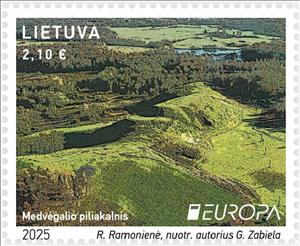Stamp: Medvėgalis Hill Fort Remains (Lithuania 2025)
Medvėgalis Hill Fort Remains (Lithuania 2025)
25 April (Lithuania ) within release Europa (C.E.P.T.) 2025 - Archaeological Discoveries goes into circulation Stamp Medvėgalis Hill Fort Remains face value 2.10 Euro
| Stamp Medvėgalis Hill Fort Remains in catalogues | |
|---|---|
| Colnect codes: | Col: LT 2025.04.25-01 |
Stamp is horizontal format.
Issued in sheets of 10 (2 x 5) stamps.Also in the issue Europa (C.E.P.T.) 2025 - Archaeological Discoveries:
- Stamp - Bilioniai Hill Fort Remains face value 2.10;
- Stamp - Medvėgalis Hill Fort Remains face value 2.10;
Stamp Medvėgalis Hill Fort Remains it reflects the thematic directions:
Archaeology or archeology[a] is the study of human activity through the recovery and analysis of material culture. The archaeological record consists of artifacts, architecture, biofacts or ecofacts, sites, and cultural landscapes. Archaeology can be considered both a social science and a branch of the humanities. It is usually considered an independent academic discipline, but may also be classified as part of anthropology (in North America – the four-field approach), history or geography
Ruins (from Latin ruina 'a collapse') are the remains of a civilization's architecture. The term refers to formerly intact structures that have fallen into a state of partial or total disrepair over time due to a variety of factors, such as lack of maintenance, deliberate destruction by humans, or uncontrollable destruction by natural phenomena. The most common root causes that yield ruins in their wake are natural disasters, armed conflict, and population decline, with many structures becoming progressively derelict over time due to long-term weathering and scavenging.


